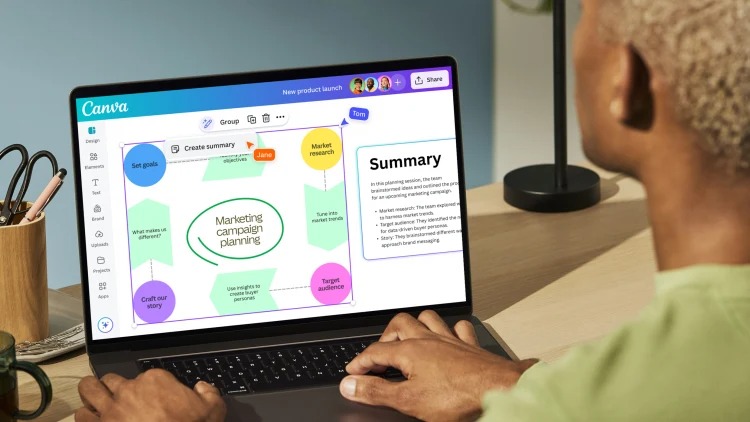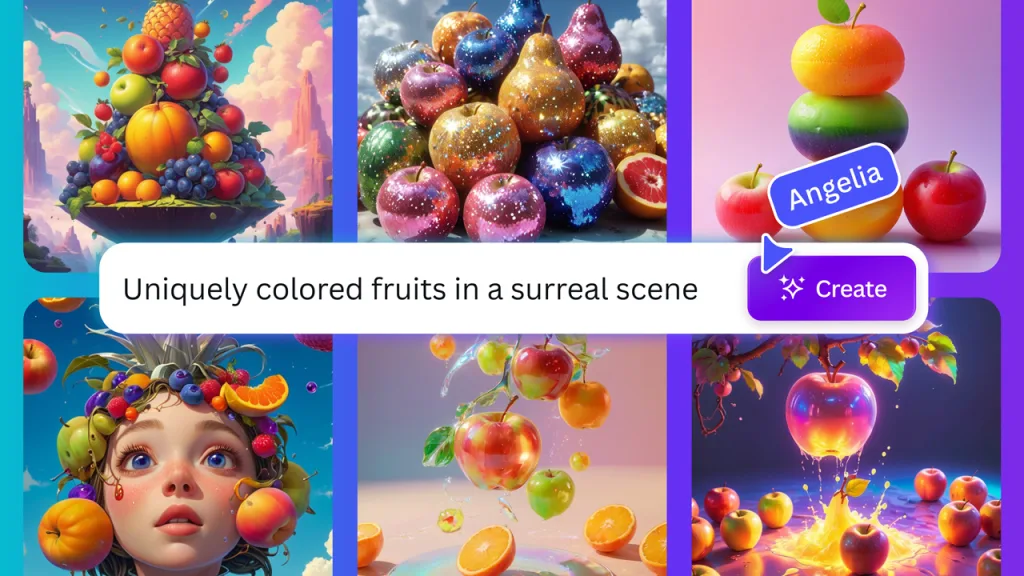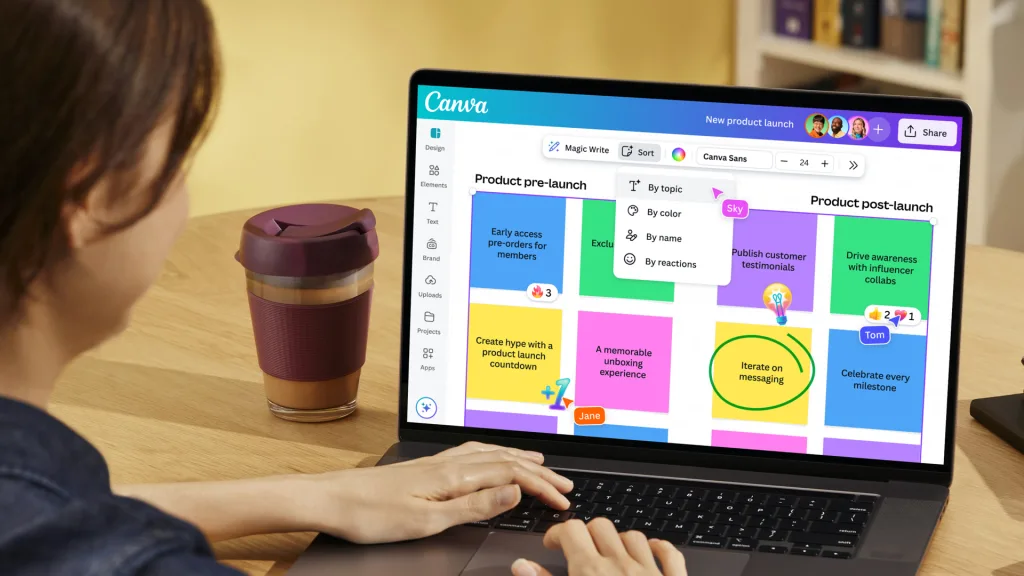- | 8:00 am
Canva CEO Melanie Perkins talks new AI tools, reverting prices, and competing with Adobe
After 10 billion AI interactions, the company is as bullish as ever on the technology.

Canva shows no signs of slowing down. Last year, the creative tools company was the first major player to integrate generative AI into its core workflow. That AI has been used 10 billion times since, during a time of considerable growth for the company.
Canva has added 75 million more users since (to reach 200 million total), increased revenue to $2.5 billion a year, and released a complete design overhaul to its Visual Suite. Today, Canva is going a few steps further. Along with dozens of updates around core product functionality, it’s revealed a completely new AI tool called Dream Lab, which lets you generate images with a text prompt, in one of 15 preset styles.
While Canva kicked off its approach to generative AI by integrating it deep into the UX of workflows (so you could create an image or generate text right inside a presentation you were working on), Dream Lab lives more superficially as its own stand-alone tab inside Canva. In this side channel, you generate higher quality images built upon a model by Leonardo AI (a company Canva acquired only three months ago), which stack atop each other like a creative timeline.
Dream Lab is, quite frankly, the more typical approach to presenting generative AI. It’s a focused space for AI, set front and center to grab the attention of anyone opening the app, rather than more slickly snuck into the UI. But according to Melanie Perkins, cofounder and CEO at Canva, it’s still about letting users create what they want to create as quickly as possible.
You got Dream Lab onto your platform in three months after acquiring Leonardo AI, which you used for its model. That’s fast! But why did you opt to make it a side app inside Canva, rather than integrated?
So AI has been used 10 billion times now on the platform. It’s been used very heavily. But what we hadn’t catered to until right now is if people just wanted to create an underwater tree house, then you previously would have to go into a presentation before you can create something like that.
This is really just catering to people that just want to be able to ideate really rapidly. What Leonardo had done a really great job of pioneering is just being able to have lots of images. So you can really just go through and ideate rapidly, and then it enables you to choose the best one. Then [you can] put that into your design, or even just download it directly.

Why not use Dream Lab for everything?
Step one was having Dream Lab as a new stand-alone product. Really what we set out to do with this first integration was to serve a need that we hadn’t yet been able to serve—so that’s having image generation straight up on the homepage.
There’s some exciting updates coming in the future, but we’re not able to share them.
My son is 10, and he’s using Canva a lot through his school. But I’ve noticed AI is so handy to use, he’ll generate an image when he could have grabbed a Canva stock photo that already exists instead. It’s becoming a reflex. Given the higher carbon impact of AI, I wonder how you’re thinking about that convenience vs. cost?
It’s fun to generate images, because it’s like your images from your mind. I think the way we continuously think about it is, when you have an idea, our job is to help remove the friction between your idea and that turning into a design as quickly as we possibly can. And so we’re continuously removing friction between those two points . . . so things that previously would be quite time consuming can now be done with a click.
I totally understand that Canva is built for speed. But I’m wondering how you’re thinking about balancing technological capability with environmental responsibility.
I think that what we’re certainly seeing is costs and compute on everything are going down over time. As far as the cost of image generation, that was radically more expensive in time gone by, and in a short period of time—just over the course of a few years—we’re seeing that radically decrease. And I think that that will continue to be the case going forward.
As a company, our goal is to be carbon negative, and we’re already doing things where Canva global operations are offset by verified, nature-based carbon credits. And so we’re continuously investing in this, and it’s a very important aspect of the company.
I’ve been seeing stats that generative AI will vastly increase the marketing output over the next few years—as 91% of ad firms are using it, we’ll just get more ads pumped into our feeds. I wonder if you have any concern for the industry you serve. Are you worried about being able to generate more marketing than people can even consume, or doing it in a way that potentially dilutes the impact?
What we’re seeing is obviously a radical transformation. [When] we introduced Canva, the idea of visual communication for everyone was a very novel concept. And I think that’s certainly started to change over the last decade. But I think that what’s really exciting to see is everything moving into more of a personalized and custom era.
Even if we look at our own workplace, previously, we might send everyone a certificate. But now, all of a sudden, everyone gets a certificate with their own personal cartoon and caption. I think what’s actually really exciting is, if it’s done well, [gen AI] can actually help people to have a more direct relationship with their community, and not just feel like an onslaught of things. The way we’re thinking about interacting with our community is, rather than it being bulk broadcast, it’s more tailored to your community and what they need and want.

Since Canva Create, where you revealed a new design and teased new software, it’s clear your platform is evolving to be less anchored in mobile to embrace deeper desktop editing. It does feel like you’re going after the “Creative Professional” with the capital C and capital P, now, in a way you didn’t even three years ago.
A helpful way that I think about it is where, if there’s a Venn diagram, there’s creativity on one side and productivity on the other side. And we started, and we are very much in the middle of that intersection between creativity and productivity. And you sort of see that through everything that we do, we bring more creativity to productivity, and more productivity to creativity.
And over time, you know that center of the Venn diagram, we’re certainly pushing out on both sides of the fence and catering to more and more of the market . . . very much driven by what our community is asking for.
This year, you’ve expanded with deeper image editing tools, and you announced a price hike of 300% (which you’ve since rescinded). Canva was built to be an Adobe alternative. But I find myself wondering, are you trending to look more like Adobe?
We actually listen to our community, which is a little bit of an atypical thing, I think. [So] we actually reverted that [decision] and are now back at the same price. That is something we believe in really deeply: actually listening to our community and listening to what they say. We always want Canva to be the very affordable option.
But what about the evolution of the platform? I can see it moving toward Adobe.
It’s really important as a company grows to continue to invest deeply in the things that got you there; and for us, that is caring deeply about our community, it’s listening to our community, building what they want and what they need, and building a product that they can trust and a company that they can trust. And so it’s something that we feel really deeply.
Close the Loop is such an important program that we have internally where we literally listen to the four million pieces of feedback and suggestions and ideas from our community that we’ve had over the past year. We actually go and build things that they’re wanting and caring about, and then we send them an email and say, “we’ve done that thing.”
You know, [we have] 200 million people using the platform—that’s a lot of people who are building their businesses, classrooms, and enterprises on the platform now, and so it’s a responsibility we take very seriously, which is why we invest so deeply in things like Close the Loop, and why we didn’t just roll forward with that price increase.
I think it’s really important to keep that DNA and to continue to invest in things that got us there. Because over the years to come, hopefully we’ll have a billion users on the platform, and it’s just an extraordinary responsibility to ensure that we’re actually listening to those communities and serving them as best as we possibly can.
This interview has been edited and condensed.





































